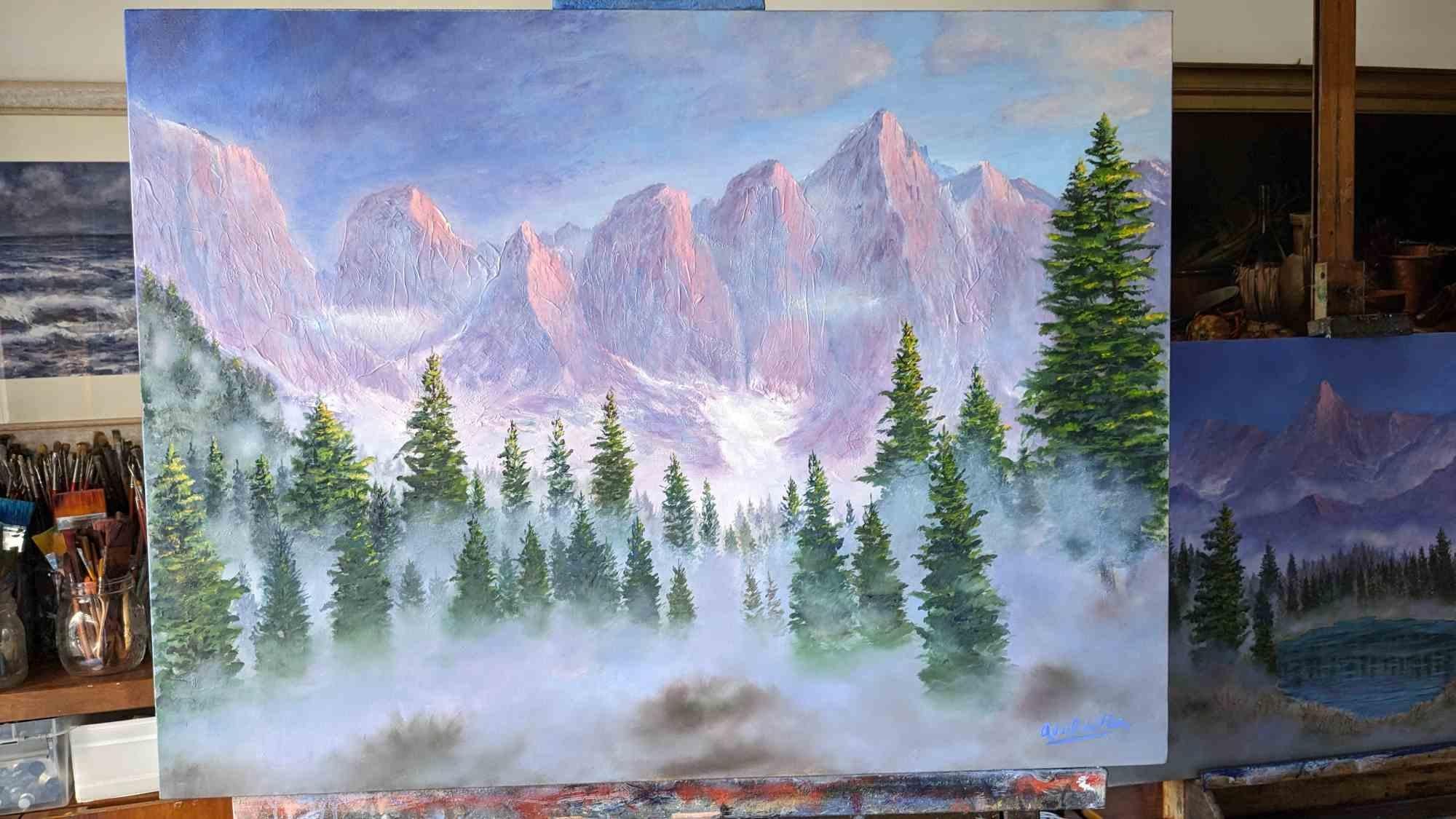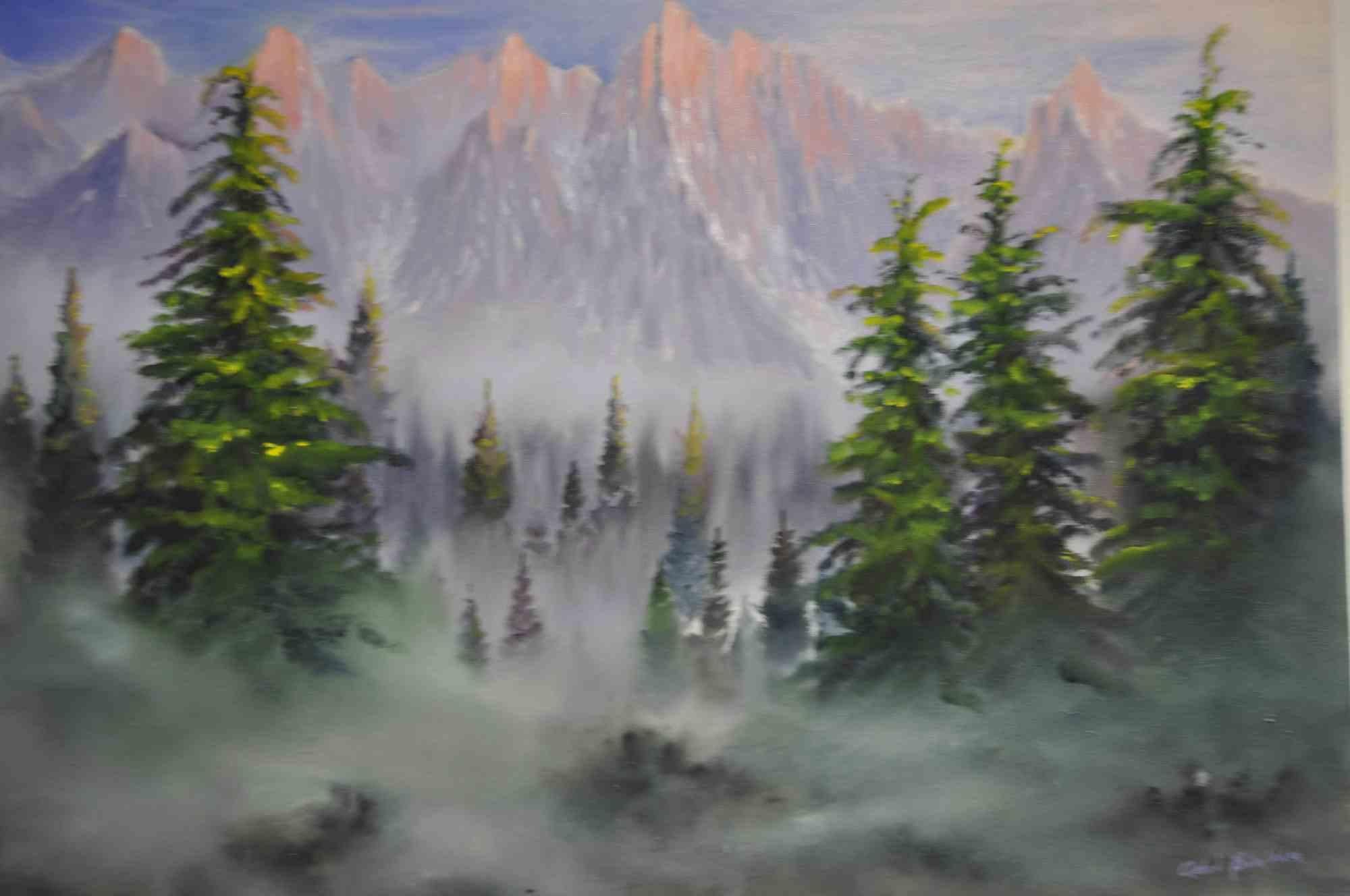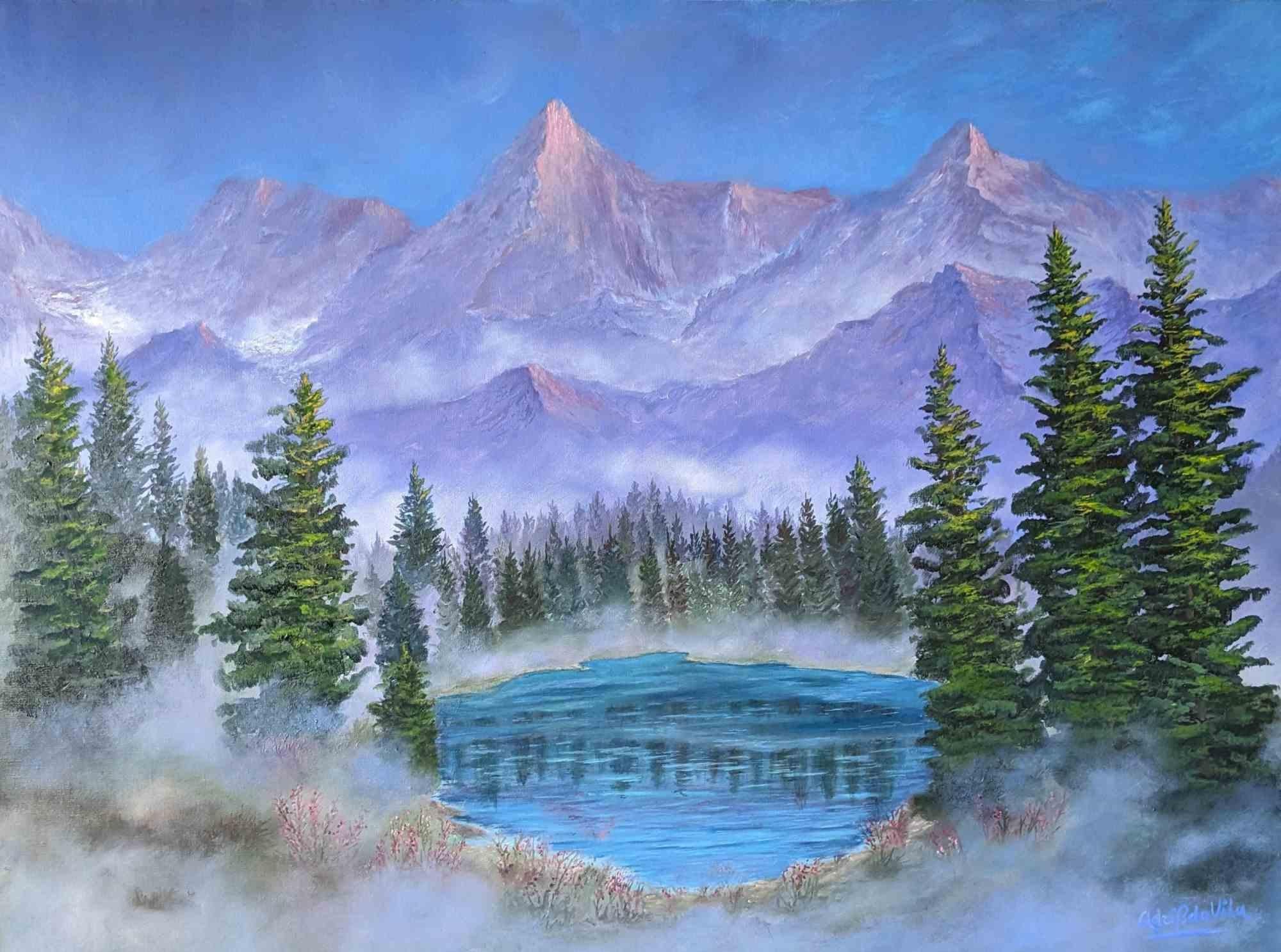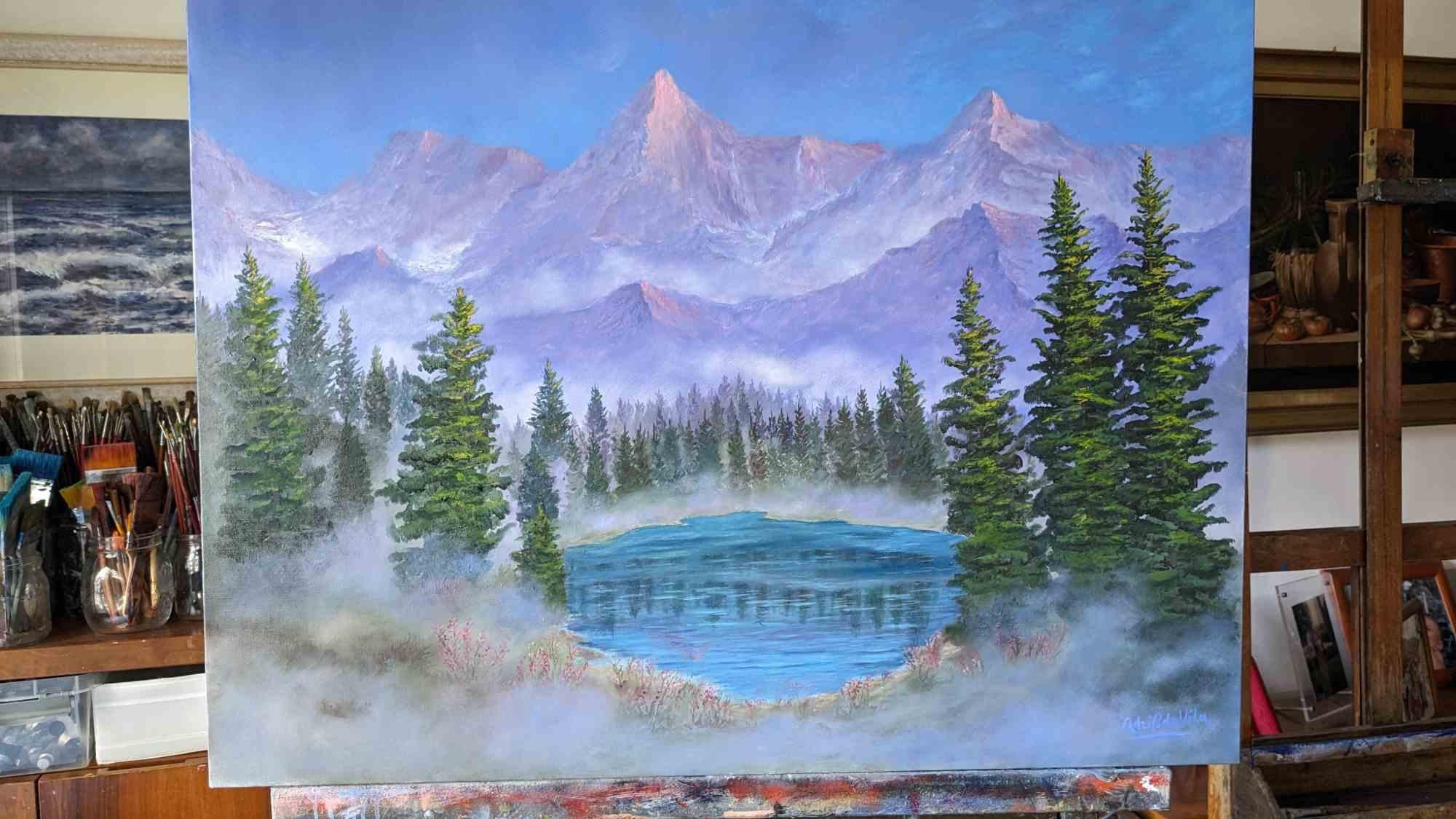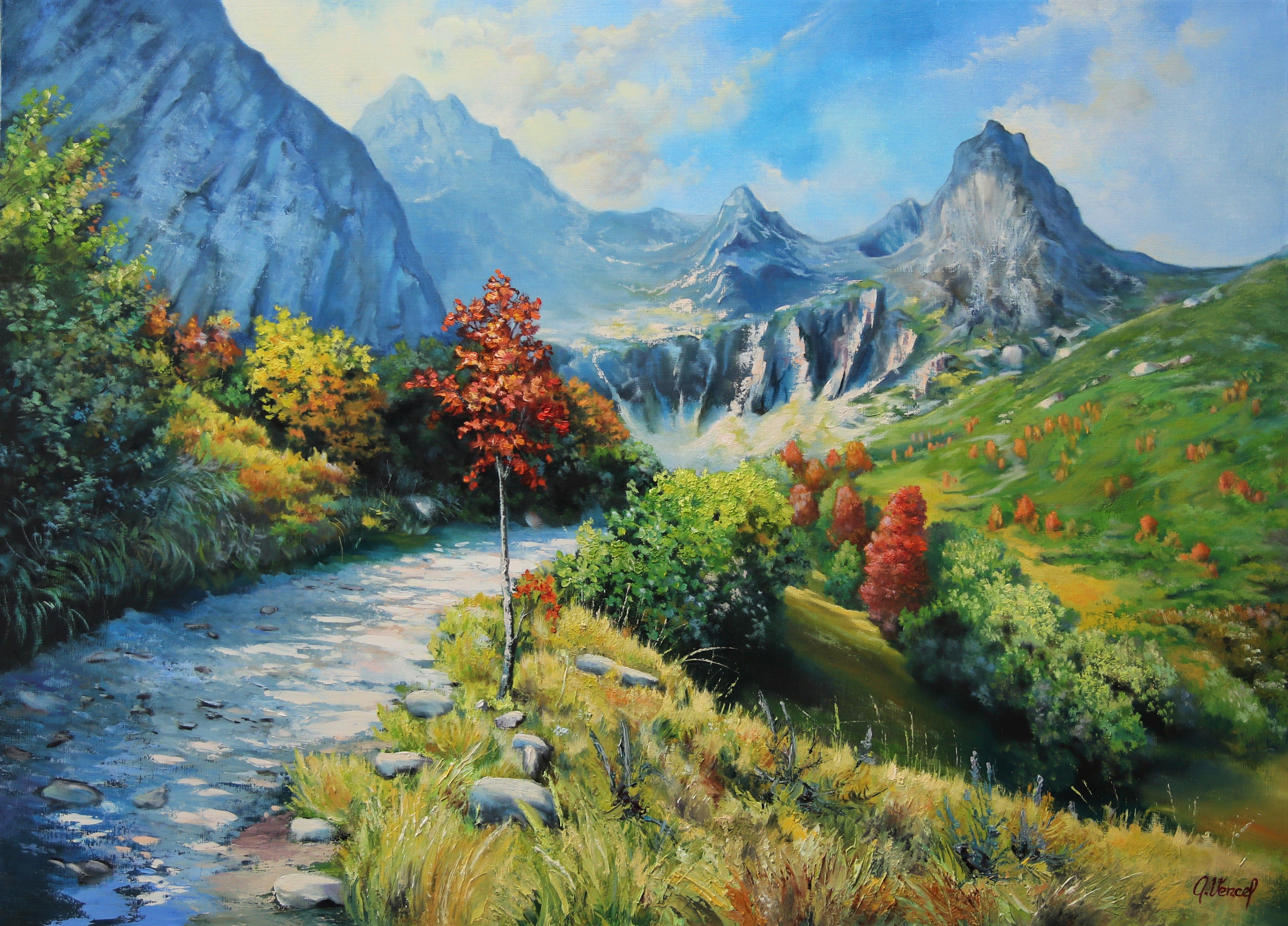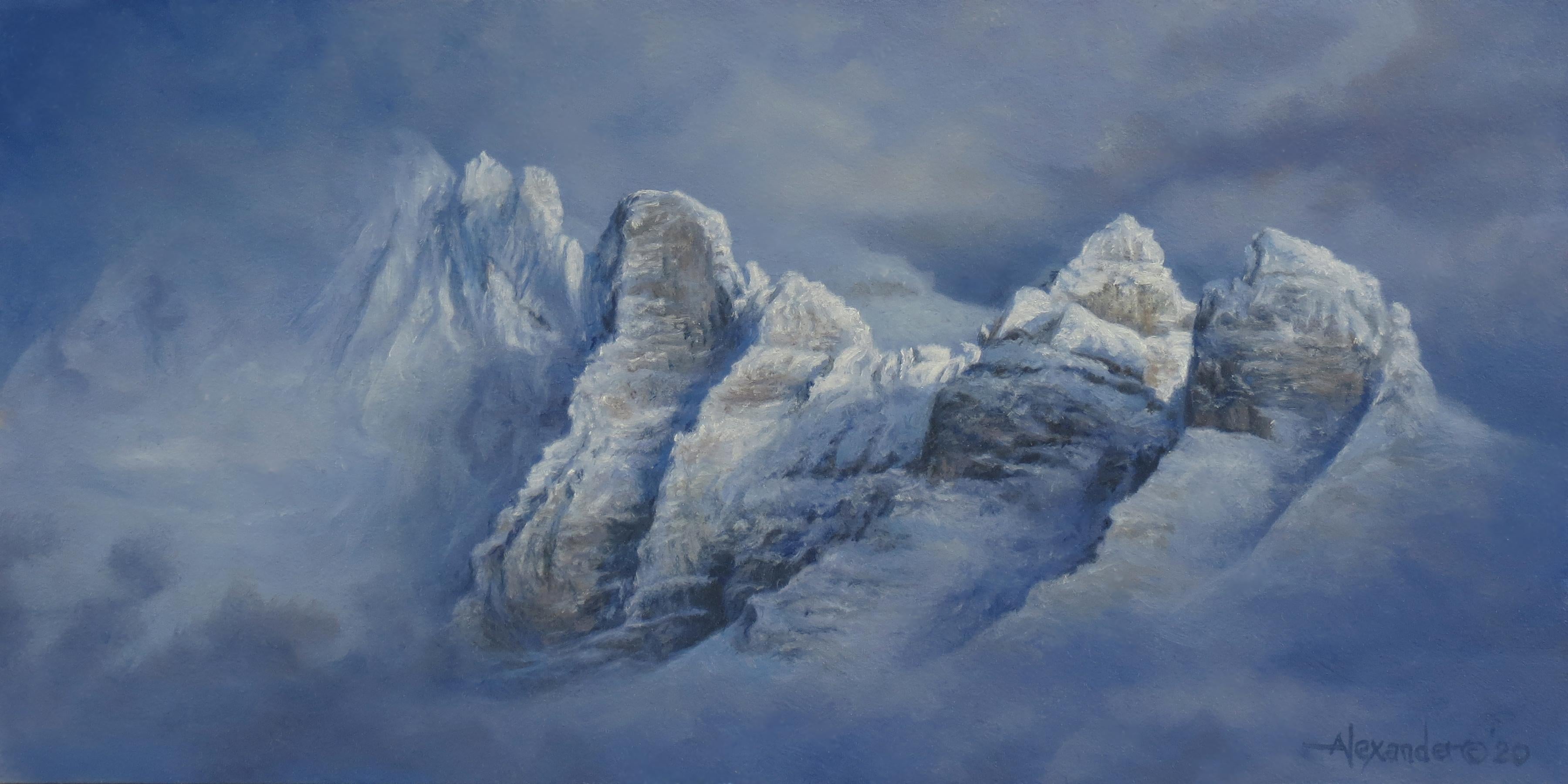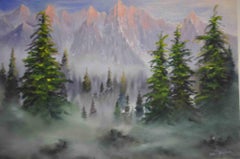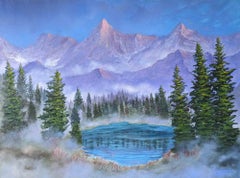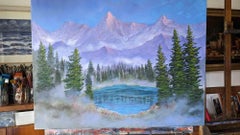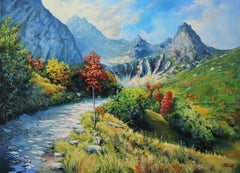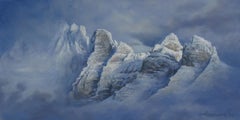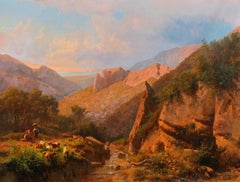Items Similar to "The Touch of the Sun" - Dolomit - Oil Paint by Adriano Bernetti Da Vila - 2023
Want more images or videos?
Request additional images or videos from the seller
1 of 5
Adriano Bernetti da Vila"The Touch of the Sun" - Dolomit - Oil Paint by Adriano Bernetti Da Vila - 20232023
2023
$6,979.41
£5,167.23
€5,800
CA$9,663.48
A$10,550.21
CHF 5,531.04
MX$128,136.37
NOK 69,073.73
SEK 65,224.02
DKK 44,156.64
About the Item
Title: "The touch of the Sun"
Composition:
The painting is dominated by a sweeping vista of the Dolomites, with the mountains rising majestically in the distance. We can see also a closer glacier. The mountains are shrouded in a delicate veil of mist, creating an ethereal and otherworldly atmosphere. As the sun begins to rise, its pink golden rays illuminating the peaks and casting shadows across the valleys.
Color Palette:
The color palette aims to evoke a sense of tranquility
The color palette is soft and muted, with shades of gray/purple, carminum red, light blue, and many different shadows of "green" for the trees that as well receive the first ray of sun on the top. The mist is rendered in delicate washes of blue pink green and white, creating a sense of haziness and ethereality. The rising sun is fare out of the scene.
Texture:
The texture of the painting is varied, with smooth washes of color for the mist, and far trees, and bolder on the mountains where I used a particular technique to highlight the rocky appearance of the mountains, inspired by the Pale di San Martino Dolomiti group, and delicate details for the other fare mountains and for the trees.
The painting aim to evoke a sense of awe and wonder at the beauty of the Dolomites. The combination of the misty atmosphere, the majestic mountains, and the forest creates a sense of tranquility and serenity. The painting is intended to be also a tribute to the beauty of the natural world and the power of nature to inspire us and to calm our soul.
The viewer could feel a sense of connection to nature, and a sense of awe at the beauty of the scene.
- Creator:Adriano Bernetti da Vila
- Creation Year:2023
- Dimensions:Height: 23.63 in (60 cm)Width: 31.5 in (80 cm)Depth: 0.99 in (2.5 cm)
- Medium:
- Movement & Style:
- Period:
- Condition:Insurance may be requested by customers as additional service, contact us for more information.
- Gallery Location:Roma, IT
- Reference Number:Seller: T-1477791stDibs: LU650314199402
About the Seller
4.9
Platinum Seller
Premium sellers with a 4.7+ rating and 24-hour response times
1stDibs seller since 2017
7,710 sales on 1stDibs
Typical response time: 2 hours
- ShippingRetrieving quote...Shipping from: Roma, Italy
- Return Policy
Authenticity Guarantee
In the unlikely event there’s an issue with an item’s authenticity, contact us within 1 year for a full refund. DetailsMoney-Back Guarantee
If your item is not as described, is damaged in transit, or does not arrive, contact us within 7 days for a full refund. Details24-Hour Cancellation
You have a 24-hour grace period in which to reconsider your purchase, with no questions asked.Vetted Professional Sellers
Our world-class sellers must adhere to strict standards for service and quality, maintaining the integrity of our listings.Price-Match Guarantee
If you find that a seller listed the same item for a lower price elsewhere, we’ll match it.Trusted Global Delivery
Our best-in-class carrier network provides specialized shipping options worldwide, including custom delivery.More From This Seller
View AllThe Touch of the Sun - Oil Paint by Adriano Bernetti Da Vila - 2023
Located in Roma, IT
Title: "The touch of the Sun"
Technique: Oil on canvas
Composition:
The painting is dominated by a sweeping vista of the Dolomites, with the mountains rising majestically in the dist...
Category
2010s Modern Figurative Paintings
Materials
Oil
Sunrise over the Dolomite - Painting by Adriano Bernetti da Vila - 2017
Located in Roma, IT
Sunrise over the Dolomites is an original artwork realized by the Italian artist Adriano Bernetti da Vila in 2017.
Hand-signed oil and acrylic on canvas 50 x 70 cm. The artwork is ...
Category
2010s Contemporary Figurative Paintings
Materials
Oil
"The Caress of Dawn"-Dolomiti - Oil Paint by Adriano Bernetti Da Vila - 2023
Located in Roma, IT
Composition:
The painting is freely inspired by Lake Carezza in the Dolomites. The painting shows a lake with the trees of the surrounding forest reflected in it, whith a sweeping vista of the Dolomites, with the mountains rising majestically in the distance, The mountains are shrouded in a delicate veil of mist, creating an ethereal and otherworldly atmosphere. As the sun begins to rise, its pink golden rays illuminating the peaks and casting shadows across the valleys.
Color Palette:
The color palette is soft and muted, with shades of blue and green for the lake, gray/purple, carminium, light blue, and many different shadows of "green" for the trees that as well receive the first ray of sun on the top. The mist is rendered in delicate washes of blue carminium red, green and white, creating a sense of haziness and ethereality. The rising sun is fare out of the scene.
Texture:
The texture of the painting is varied, with smooth washes of color for the mist, and far trees, and delicate details for the other fare mountains and for the trees.
Freely inspired to Lake Carezza area, the paint aims creating a dreamier atmosphere. Hence, the title is "The Caress...
Category
2010s Modern Figurative Paintings
Materials
Oil
The Caress of Dawn - Oil Paint by Adriano Bernetti Da Vila - 2023
Located in Roma, IT
Dolomites: The mountains are distant, delicate, basking in the first morning sunbeam. In the lake with its typically alpine colors, the trees of the forest are reflected amidst the m...
Category
2010s Modern Figurative Paintings
Materials
Oil
Mountain Mystery - Oil Paint by Elena Mardashova - 2023
Located in Roma, IT
Original oil painting on canvas 70X50 cm, entitled Mountain Mystery.
Excellent condition.
Category
2010s Contemporary Figurative Paintings
Materials
Canvas, Oil
Primal Force - Painting by Adriano Bernetti da Vila - 2021
Located in Roma, IT
Primal Force is an original artwork realized by the Italian artist Adriano Bernetti da Vila in 2021.
Hand-signed oil on canvas 80 x 80 cm. The artwork is a representation of the pri...
Category
2010s Contemporary Figurative Paintings
Materials
Oil
You May Also Like
Mountain landscape, Painting, Oil on Canvas
By Attila Vencel
Located in Yardley, PA
Mountain ranges are among my favourite sights. Their majesty rises across the horizon and reminds me of how magnificent powerful nature is. Rocks literally thrusted from the ground ...
Category
2010s Romantic Landscape Paintings
Materials
Oil
"Sunlit Heights" Oil Painting
Located in Denver, CO
Rob Alexander's "Sunlit Heights" is an original, handmade oil painting that depicts snow capped blue mountains rising from the mist.
This painting is c...
Category
2010s Realist Landscape Paintings
Materials
Oil, Wood Panel
Large Italian Mountain Landscape Painting by Andreas Marko
By Andreas Marko
Located in Rochester, NY
A monumental Italian landscape oil painting. "Apuan Mountains" of Italy (The Italian Alps) Shepherds in the mountains with the village of Seravezza below. Painted by Andreas Marko ...
Category
19th Century Landscape Paintings
Materials
Fabric, Canvas, Oil
Czech Switzerland, Painting, Oil on Canvas
By Attila Vencel
Located in Yardley, PA
My childhood memories. Remembering growing up with my grandfather who was my biggest influence and role model. :: Painting :: Romanticism :: This piece comes with an official certi...
Category
21st Century and Contemporary Romantic Paintings
Materials
Oil
Touch Of Sunlight. Oil painting
Located in Zofingen, AG
Summer evenings always admire the artist. Nikolay was looking for the ways to capture the evening glow on the canvas many years.
The artist used a unique way to create the effect of ...
Category
2010s Impressionist Landscape Paintings
Materials
Oil, Cardboard
Alpine View, Original oil Painting, Ready to Hang
By Vahe Yeremyan
Located in Granada Hills, CA
Artist: Vahe Yeremyan
Work: Original Oil Painting, Handmade Artwork, One of a Kind
Medium: Oil on Canvas
Year: 2024
Style: Contemporary Art,
Title: Alpine View,
Size: 44" x 30" x...
Category
2010s Impressionist Landscape Paintings
Materials
Canvas, Oil
